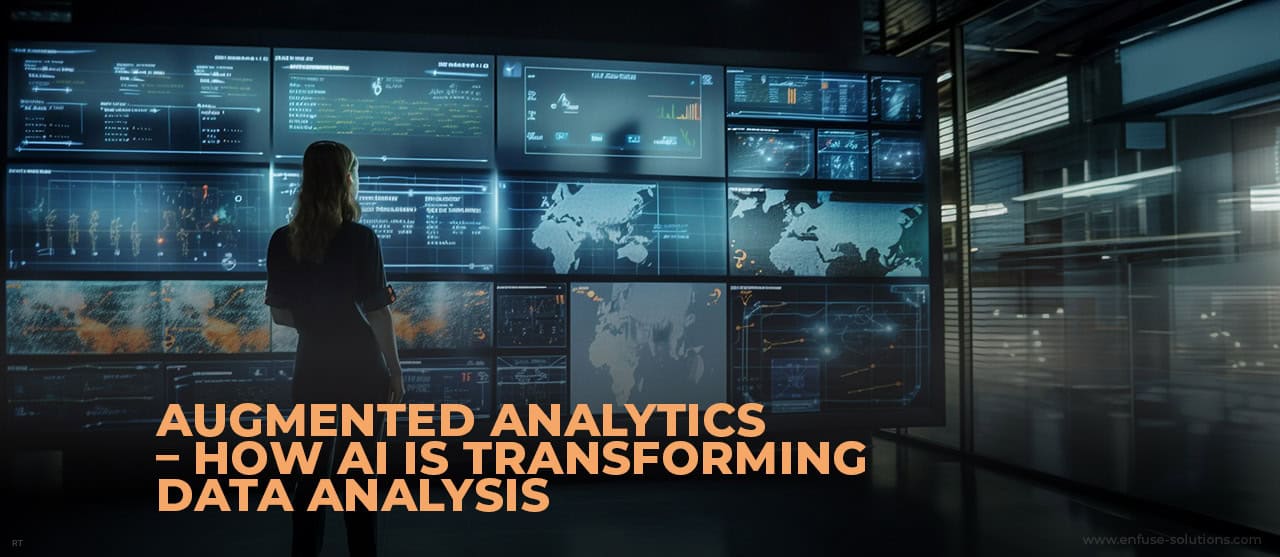
The sheer volume of information generated every day can be overwhelming for enterprises. Hence, the proliferation of big data analytics bodes well. But as companies wrestle with how to best analyze the massive amounts of information at their disposal, they must leverage the power of AI.
This is where “Augmented Analytics” comes into play, which blends the power of human experience with AI to revolutionize the way we make sense of data.
What Is Augmented Analytics?
Gartner concretely defines augmented analytics as “the use of enabling technologies such as machine learning and AI to assist with data preparation, insight generation, and insight explanation.” This is done to augment how data is explored and analyzed “in analytics and BI platforms.”
Simply put, augmented analytics is a sophisticated data analysis approach that combines the power of AI and machine learning to assist human analysts in uncovering insights, trends, and patterns within vast datasets.
Essentially, augmented analytics takes the guesswork out of making decisions, leading to more accurate predictions that aren’t simply reliant on gut feelings or intuition. This allows data scientists to be more objective in their analysis.
The Integration Of AI And Its Influence
The integration of AI in data analysis is at the core of augmented analytics. Let’s dig deep into some of the many ways AI is employed in this context:
1. Use Of ML Algorithms In Data Analysis
In order to “augment” analytics, a data scientist would need to identify patterns in the data that are relevant and meaningful. Ideally, this would be done with the end goal of producing a useful prediction. The most common way to do this is through machine learning algorithms. Algorithms that automatically learn how to function by themselves are called “supervised” algorithms.
The results of supervised learning can be used for other predictions in the future. To illustrate this, let’s consider an example from the eCommerce domain. Imagine a large online retailer with millions of customers and a vast product catalog, and they are interested in optimizing their product recommendations to boost sales and enhance customer satisfaction.
In this scenario, supervised machine learning algorithms come into play. The retailer leverages historical data on customer behavior (encompassing purchase history, product views, and search queries, along with customer demographics) to initiate training of a recommendation system. This system assumes the role of an “algorithm supervisor,” directing it toward comprehension of preferred products for diverse customers.
2. Natural Language Processing For Data Comprehension
While ML algorithms are used to identify patterns in data, NLP algorithms can help understand the implications of those patterns. For example, NLP can be used to infer customer sentiment from online reviews — similar to how a human being would do it.
The use of NLP in the analysis process makes the whole process much faster and easier, as it doesn’t require data scientists to manually go through every permutation of data to see whether a particular pattern is showing up consistently.
This is particularly valuable when dealing with substantial unstructured text data like customer reviews or social media comments. In marketing and sales, NLP aids in customer behavior analysis and targeting, allowing companies to respond to customer sentiment effectively and tailor their marketing efforts accordingly.
3. Data Visualization & Pattern Recognition Through AI
AI-driven data visualization tools transform raw data into easily understandable charts, graphs, and dashboards. These visual representations not only simplify complex data but also enable analysts to spot trends and outliers quickly.
In healthcare, for instance, visualizations powered by augmented analytics are invaluable for disease diagnosis and patient monitoring. These dynamic and comprehensive visual representations, often derived from a multitude of patient data sources, enable healthcare professionals to make quicker and more accurate decisions.
For instance, integrating a patient’s medical history, real-time monitoring data, and medical imaging into a single visualization provides a holistic view of a patient’s health, making it easier to detect patterns and anomalies that might be elusive when analyzing separate data streams.
Pattern recognition algorithms, on the other hand, help identify recurring patterns in data, which is crucial for making informed decisions. The beauty of augmented analytics is that it allows a company to see how one particular pattern is affecting other patterns.
For example, if a particular marketing campaign in the past resulted in decreased revenue, an augmented analytics model can easily predict what will happen if you run the same marketing campaign again. This helps eliminate the guesswork that many businesses are plagued with when trying to make predictions about future events.
The Bottom Line
Augmented analytics is actively reshaping organizations’ approach to data analysis. By harnessing AI’s power in data analysis, businesses can uncover valuable insights, streamline their decision-making processes, and gain a competitive edge within their respective industries.
Eager to harness the transformative power of augmented analytics and unlock its potential for your organization? Partner with EnFuse — a leading provider of AI-driven data analysis solutions. Through our services at EnFuse, you can tap into your data’s full potential, thus positioning your organization at the forefront of this data-driven era. Get in touch with us today!

















Comment